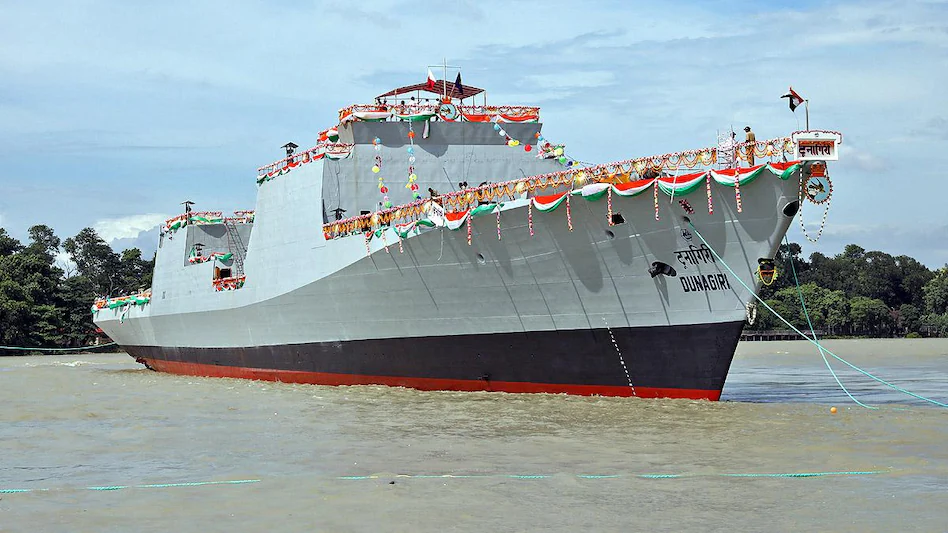Stealth Frigate What The Launch Of INS Dunagiri Means For Indian Naval Defence

- The 17A frigates are named after the former Nilgiri-class frigates that served in the Indian Navy from 1972 to 2013.
- The ships make extensive use of low-observability technologies, such as composite materials and radar-absorbing coatings.
On Friday, Defence Minister Rajnath Singh sailed the Indian Navy Ship (INS) Dunagiri into the Hooghly River near Kolkata. The ship is one of seven stealth frigates being built by India under Project 17A.
“Lord Hanuman brought the entire Dronagiri mountain to bring Lord Laxman the’sanjeevani booti.’ Dronagiri or Dunagiri can also bring its work to a close in any situation “After launching the frigate, the Minister stated that the ship will be a valuable asset to the country. It is expected to be a watershed moment for INS Dunagiri, as launching means the ship can float while the rest of the construction, including the superstructure, is completed.
“The launch of the fourth ship in such a short period attests to the impetus provided towards self-reliant shipbuilding with a focused approach,” the Ministry of Defence stated (MoD).
Dunagiri is a reincarnation of a previous frigate of the same name. According to the Defence Ministry, the former was a Leander class ASW frigate that saw various challenging operations and multinational exercises during her 33 years of service from May 1977 to October 2010.
In October 2010, it was decommissioned.
The 17A frigates are named after the former Nilgiri-class frigates that served in the Indian Navy from 1972 to 2013. The names of the first six ships in the series were taken from the older class: Nilgiri, Himgiri, Taragiri, Udaygiri, Dunagiri, and Vindhyagiri.
These seven Project 17A frigates are the first Indian warships to incorporate modular shipbuilding technologies, for which the shipyards of Mazagon Dock Shipbuilders (MDL) and Garden Reach Shipbuilders & Engineers (GRSE) have been significantly upgraded.
All frigates in Project 17 are named after mountain ranges in India, beginning with INS Shivalik in 2010, INS Satpura in 2011, and INS Sahyadri in 2012.
Stealth aids in Naval defence missions
INS Dunagiri is the fourth warship in Project 17A, a series of guided-missile frigates being built by MDL and GRSE for the Indian Navy. The first two Project 17A warships, INS Nilgiri and INS Himgiri, were launched in 2019 and 2020, respectively. INS Udaygiri, the third ship, was launched in May of this year. This series includes 6,600-tonne guided missile frigates with advanced stealth features, advanced weapons and sensors, and platform management systems.
The ships make extensive use of low-observability technologies, such as composite materials and radar-absorbing coatings. These materials help the ship maintain a low radar cross-section (RCS). Furthermore, the physical profile of the vessel aids in stealth.
It has an enclosed mooring deck, flush-mounted weapon systems, and fewer antennae. The ship has a subtle physical design and visual profile, as well as improved roll stabilisation. This allows it to quickly enter enemy territory during maritime conflicts.
A step towards ‘Aatmanirbharta’
All of Project 17A’s guided missile frigates, including Dunagiri, were designed in-house by the Indian Navy’s Directorate of Naval Design (DND), which has also led the design of many other classes of homemade warships in the past. “This is a testament to the nation’s unwavering efforts toward ‘Aatmanirbharta,’ as indigenous firms, including MSMEs (medium, small, and micro enterprises),” the ministry said. Furthermore, the new vessels are made of steel that was developed in-house.
The Leander-class frigates are known as the “Nilgiri-class” after the first vessel in the class. These were the first Indian warships that the Navy designed and indigenised on a large scale.







Facebook Comments